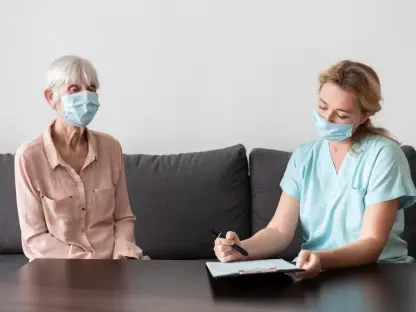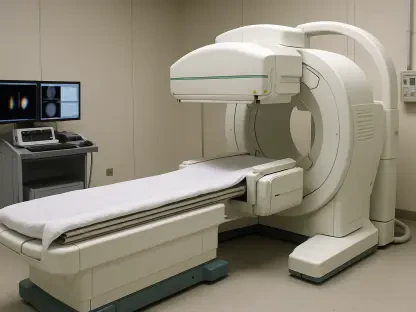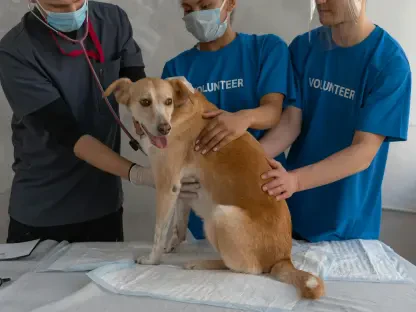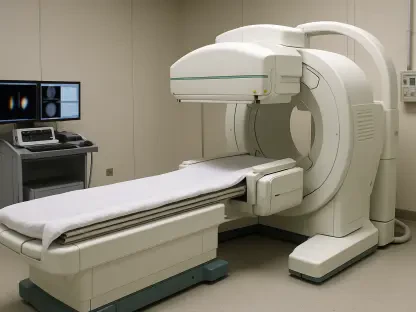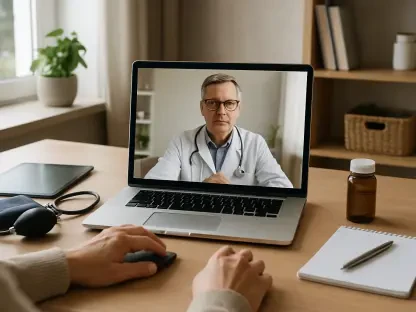In a remarkable stride forward for medical diagnostics, a recent study from Wuhan, China, has unveiled the extraordinary potential of artificial intelligence to detect airway foreign bodies that often elude even the most experienced radiologists. Published in a prominent medical journal, this research highlights how AI can identify radiolucent objects—those nearly invisible on standard imaging like X-rays and CT scans—with a precision that significantly surpasses human capability. These hidden blockages, frequently food fragments or plant material, can lodge in the airways, causing persistent symptoms such as chronic cough or recurrent infections, yet they often remain undiagnosed for months due to their subtle appearance. The implications of this technology are vast, offering a pathway to faster, more accurate diagnoses that could alleviate patient suffering and reduce delays in critical treatments. This breakthrough not only addresses a longstanding clinical challenge but also signals a transformative shift in how technology can support healthcare professionals in tackling complex diagnostic hurdles.
Unseen Dangers in the Airways
The challenge of detecting radiolucent foreign bodies in the airways is a persistent issue in medical imaging, as these objects possess a low density that allows them to blend almost seamlessly with surrounding tissues on conventional scans. Often, these blockages—think small bits of food or organic matter—go unnoticed on X-rays and even detailed CT scans, leading to misdiagnoses like pneumonia or asthma. Patients, particularly young children and the elderly, may endure ongoing discomfort, including chronic coughing or breathing difficulties, without a clear understanding of the root cause. This diagnostic oversight can result in prolonged health issues, with some individuals facing recurrent lung infections or more severe respiratory complications over time. The inability to spot these hidden threats underscores a critical gap in current imaging practices, where even advanced tools fall short in revealing the full picture of a patient’s condition.
For radiologists, the task of identifying these elusive objects is incredibly daunting, even with years of specialized training in thoracic imaging. The subtle signs of a foreign body often get lost amidst the intricate anatomy of the airways, where distinguishing between normal tissue and an obstruction requires exceptional attention to detail. Studies have shown a high rate of missed cases, as human interpretation struggles to pick up on faint or ambiguous indicators in scans. This limitation is not a reflection of skill but rather an inherent challenge in visualizing materials that lack contrast against their surroundings. The consequences of such misses are significant, often delaying necessary interventions like bronchoscopy, which is the definitive method to locate and remove blockages. This persistent problem highlights the urgent need for a supplementary tool that can enhance detection capabilities beyond human limits.
A Technological Leap in Diagnosis
A groundbreaking AI system developed by researchers in Wuhan offers a promising solution to the diagnostic blind spot of radiolucent airway foreign bodies. By integrating a 3D mapping tool known as MedpSeg to reconstruct the bronchial tree from routine chest CT scans, alongside an image classifier called ResNet-18 to analyze multiple perspectives of the airways, this technology achieves a recall rate of 71% in identifying true cases. This performance nearly doubles the 36% recall rate of seasoned radiologists in a controlled, blinded test involving numerous cases. Such a stark improvement means that many more patients with hidden blockages could be flagged for further investigation, potentially preventing months of misdiagnosis and discomfort. The AI’s ability to detect what often goes unseen represents a significant leap forward in medical imaging, paving the way for more effective clinical outcomes.
Beyond its impressive detection rates, the practicality of this AI system makes it a viable addition to hospital settings worldwide. Designed to operate on standard CT scan data, it requires no specialized equipment or additional imaging protocols, ensuring that it can be seamlessly integrated into existing workflows. The technology acts as a digital assistant, highlighting suspicious areas on scans for radiologists to review, thereby reducing the likelihood of overlooking critical findings under time pressure or fatigue. This compatibility with routine processes is crucial, as it minimizes disruption while maximizing diagnostic support. As a result, clinicians can make more informed decisions about whether to proceed with invasive procedures like bronchoscopy, ensuring that patients receive timely interventions without unnecessary delays or repeated testing.
Enhancing Clinical Decision-Making
Central to the design of this AI technology is its role as a supportive tool rather than a replacement for human expertise in medical diagnostics. It is engineered to complement the skills of radiologists and pulmonologists by providing a second layer of analysis that can catch subtle anomalies often missed during initial reviews. By flagging potential foreign bodies in airway scans, the system empowers clinicians to focus their attention on high-risk cases, ensuring that critical decisions—such as whether to perform a bronchoscopy—are based on comprehensive insights. This collaborative dynamic preserves the essential role of clinical judgment while mitigating the risk of human error, particularly in complex or ambiguous cases where visual cues are minimal. The result is a balanced approach that enhances diagnostic accuracy without undermining the expertise of healthcare professionals.
This supportive capacity becomes even more vital in environments where access to specialized medical personnel is limited or unavailable. In smaller hospitals or during after-hours shifts, where thoracic radiologists may not be on hand, the AI can function as a virtual second opinion, ensuring that urgent cases are not overlooked due to staffing constraints. Such a capability is particularly beneficial in rural or under-resourced settings, where patients might otherwise face long waits for expert consultation. By bridging this gap, the technology helps standardize diagnostic quality across diverse healthcare landscapes, reducing disparities in care delivery. This potential to support clinicians in varied contexts underscores the AI’s value as a flexible and inclusive tool that prioritizes patient well-being above all else.
Impact on High-Risk Groups
The introduction of AI-driven detection holds profound implications for vulnerable populations who are disproportionately affected by airway foreign body aspiration. Young children, prone to putting objects in their mouths, and older adults, who may struggle with swallowing due to age-related conditions, face heightened risks of such incidents. Often, their symptoms are atypical or difficult to articulate, leading to delays in identifying the true cause of their respiratory distress. This technology could dramatically shorten the diagnostic timeline by pinpointing hidden blockages early, thus preventing complications like chronic infections or lung damage. For these groups, the difference between months of uncertainty and a swift resolution can be life-changing, alleviating both physical suffering and the emotional toll of prolonged medical uncertainty.
On a systemic level, the benefits of this AI tool extend to healthcare efficiency and resource allocation, particularly for communities with limited medical infrastructure. By facilitating earlier detection, it reduces the need for repeated doctor visits, unnecessary treatments like antibiotics, and extended hospital stays that often accompany misdiagnosed aspiration cases. This not only lowers costs for healthcare systems but also frees up capacity for other critical needs, a significant advantage in understaffed or overstretched facilities. Furthermore, the technology’s ability to support accurate diagnoses in diverse settings ensures that even patients in remote areas can access a level of diagnostic precision previously reserved for major medical centers. Such widespread impact highlights how AI can address both individual and collective challenges in managing airway-related emergencies.
Paving the Way for Future Innovations
Looking ahead, the success of this AI system in detecting airway foreign bodies opens numerous avenues for further refinement and broader application in medical diagnostics. Expanding testing to include diverse patient demographics, varied imaging equipment, and different geographic regions will be essential to validate its effectiveness across global healthcare settings. Additionally, integrating clinical data—such as a patient’s history of choking or symptom patterns—into the AI model could enhance its precision, reducing false positives while maintaining high recall rates. Addressing concerns about radiation exposure from CT scans, especially for pediatric cases, might involve exploring lower-dose imaging options or alternative modalities that still provide sufficient data for analysis. These steps will ensure the technology remains both safe and adaptable to evolving medical needs.
Reflecting on the strides made, it’s clear that this research marks a pivotal moment in the integration of AI into clinical practice. The system’s ability to outperform human experts in identifying elusive blockages demonstrates a tangible improvement in diagnostic accuracy, offering hope to countless patients who previously faced delayed interventions. Its design as a supportive tool ensures that clinicians retain control over final decisions, fostering trust in the technology’s role within healthcare. While challenges like limited study scope and imaging constraints are acknowledged, the foundation laid by this work inspires confidence in future advancements. The potential to save time, reduce suffering, and equalize access to quality diagnostics lingers as a lasting impact, urging continued investment in AI solutions that could transform patient care on a global scale.



